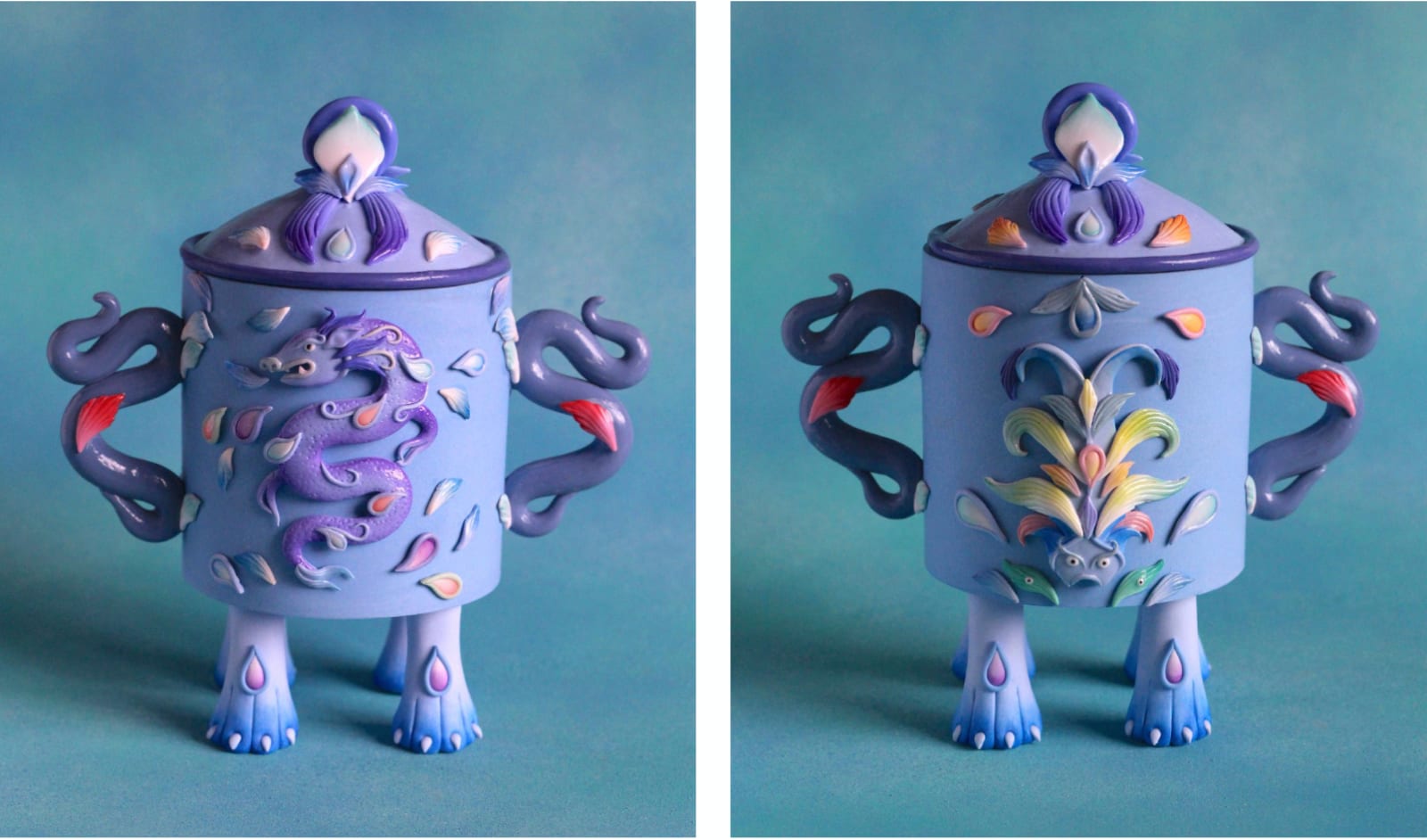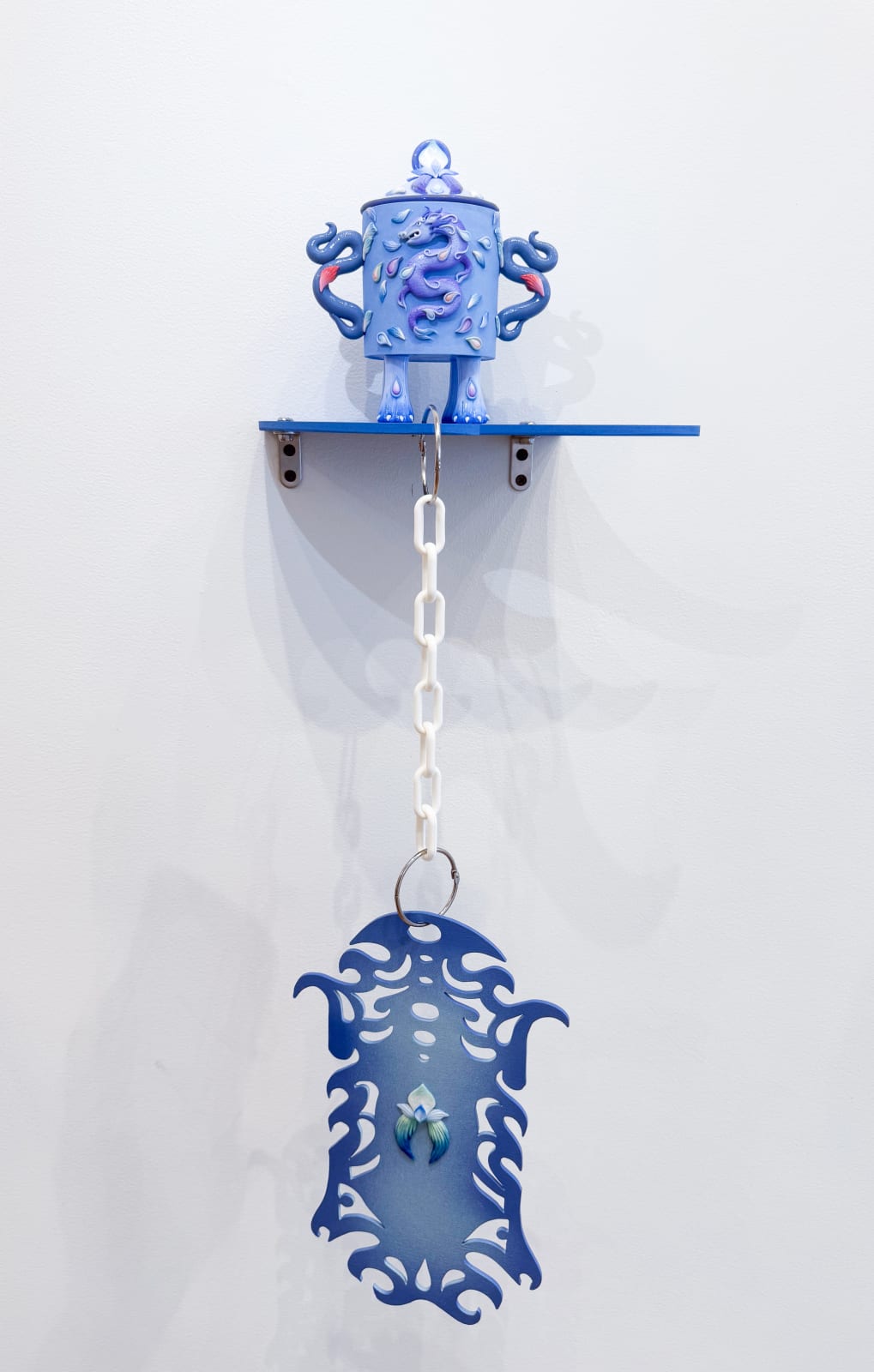







Hannah Lim
Violet Dragon Snuff Bottle, 2025
Jesmonite, polymer clay, chalk, acrylic paint and resin gloss
6.30 x 7.48 x 4.72 in
16 x 19 x 12 cm
16 x 19 x 12 cm
Copyright Upsilon Gallery
Further images
-
(View a larger image of thumbnail 1
)

-
(View a larger image of thumbnail 2
)

-
(View a larger image of thumbnail 3
)

-
(View a larger image of thumbnail 4
)

-
(View a larger image of thumbnail 5
)

-
(View a larger image of thumbnail 6
)

-
(View a larger image of thumbnail 7
)

-
(View a larger image of thumbnail 8
)

My practice has been a way for me to explore parts of my cultural identity. As a woman of mixed Chinese-Singaporean and British heritage, my work explores the relationship between these...
My practice has been a way for me to explore parts of my cultural identity. As a woman of mixed Chinese-Singaporean and British heritage, my work explores the relationship between these cultures, looking at how this has been reflected historically through design, objects, architecture and mythology. I often create works that reflect on the history of different cultural designs and motifs with emphasis on exploring how particular design styles can be reimagined and reinterpreted in more conscientious ways.
During my degree, I became particularly intrigued by the 18th-century design trend, Chinoiserie. A trend through which elements of Chinese design and culture were recreated and imitated in relation to European aesthetics and tastes. In my own work, I attempt to reclaim and re-imagine this practice, using the process as a way to also connect with my own heritage.
The three snuff bottles in the show all feature creatures, both real and mythical, gathered from texts on Chinese and Medieval mythology and bestiaries. I recently became particularly intrigued by ‘The Classic of Mountains and Seas’; an ancient Chinese mythological geographical anthology. I’ve been attempting to interpret the text through my work, using the enchanting alchemic descriptions of these creatures as inspiration for my most recent series of sculptures and paintings.
What intrigued me most about this anthology were the intricate descriptions of each of the creatures referenced; their appearance, the noises they made, their healing qualities (if ingested), their symbolic significance - many of these creatures were symbols of fertility, good luck, health, love and resilience. I liked the way these creatures could become so imbued with meaning and significance, to the point where images or depictions of them became a symbol of strength or a reminder of hope. The three snuff bottles are decorated with sculpted details depicting fish, dragons, plants and symbols all with layered means related to renewal, prosperity, strength and love.
The ‘Snuff Bottles’ are part of a collection of works inspired by the designs of traditional snuff bottles that I’ve come across in the Chinese collections of many British museums. I was particularly intrigued by the intricacy and vibrance of these snuff bottles and they became for me a visual emblem of my heritage.
My own snuff bottle-like works are far larger than the traditional designs and are often anthropomorphised with arms, legs and eyes. They also don’t maintain the functionality of the original objects - they don’t contain snuff. They are however very intricate and ornate, similar to real snuff bottles.
I've also become interested in exploring the parallels between Chinese bestiaries and Medieval bestiaries, which often surprisingly recount very similar creatures and beasts and yet the religious and philosophical significance of these creatures varies greatly. Dragons in particular are a prominent feature within both European and East/South East Asian mythology. I love merging different depictions and characteristics of these creatures within my work. These cultural crossovers are of particular interest to me and feature prominently within both my sculptures and paintings.
- Hannah Lim
During my degree, I became particularly intrigued by the 18th-century design trend, Chinoiserie. A trend through which elements of Chinese design and culture were recreated and imitated in relation to European aesthetics and tastes. In my own work, I attempt to reclaim and re-imagine this practice, using the process as a way to also connect with my own heritage.
The three snuff bottles in the show all feature creatures, both real and mythical, gathered from texts on Chinese and Medieval mythology and bestiaries. I recently became particularly intrigued by ‘The Classic of Mountains and Seas’; an ancient Chinese mythological geographical anthology. I’ve been attempting to interpret the text through my work, using the enchanting alchemic descriptions of these creatures as inspiration for my most recent series of sculptures and paintings.
What intrigued me most about this anthology were the intricate descriptions of each of the creatures referenced; their appearance, the noises they made, their healing qualities (if ingested), their symbolic significance - many of these creatures were symbols of fertility, good luck, health, love and resilience. I liked the way these creatures could become so imbued with meaning and significance, to the point where images or depictions of them became a symbol of strength or a reminder of hope. The three snuff bottles are decorated with sculpted details depicting fish, dragons, plants and symbols all with layered means related to renewal, prosperity, strength and love.
The ‘Snuff Bottles’ are part of a collection of works inspired by the designs of traditional snuff bottles that I’ve come across in the Chinese collections of many British museums. I was particularly intrigued by the intricacy and vibrance of these snuff bottles and they became for me a visual emblem of my heritage.
My own snuff bottle-like works are far larger than the traditional designs and are often anthropomorphised with arms, legs and eyes. They also don’t maintain the functionality of the original objects - they don’t contain snuff. They are however very intricate and ornate, similar to real snuff bottles.
I've also become interested in exploring the parallels between Chinese bestiaries and Medieval bestiaries, which often surprisingly recount very similar creatures and beasts and yet the religious and philosophical significance of these creatures varies greatly. Dragons in particular are a prominent feature within both European and East/South East Asian mythology. I love merging different depictions and characteristics of these creatures within my work. These cultural crossovers are of particular interest to me and feature prominently within both my sculptures and paintings.
- Hannah Lim